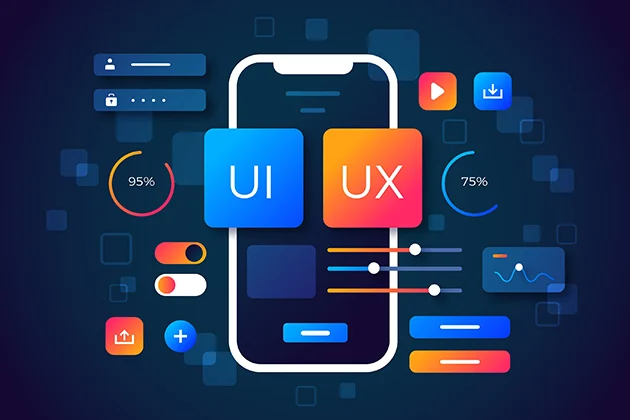Design determines the way users interact with digital products. Whether it’s viewing a website, accessing an application on a mobile, or working within software programs, the experience relies on both aesthetics and structure. However, most individuals unwittingly equate User Experience (UX) and User Interface (UI) design.
While these fields collaborate closely, they have different roles. Understanding the actual difference between UX and UI design is more than semantic—it has real-world consequences for design success, staffing, and creating solutions that work for users. That’s why UI UX design agencies emphasize the importance of separating these disciplines while fostering seamless collaboration between them.
This piece dissects UX and UI from both functional and visual angles. It looks at what they entail, how they overlap, and why companies need to know about both to provide exceptional digital experiences.
Understanding UX and UI Design: Core Definitions
What is UX Design?
User Experience design focuses on the structure, flow, and logic of how a person uses a product. It answers critical questions:
- Is the process intuitive?
- Does the product meet user expectations?
- How efficiently can users complete tasks?
UX designers are concerned with the entire interaction cycle. Their work involves:
- Conducting UX research and testing
- Creating user personas
- Mapping user journeys
- Structuring wireframes
- Validating usability through feedback loops
A UX designer thinks like an architect—organizing space and flow before the visual touches begin.
What is UI Design?
User Interface design refers to the visual components users interact with on a screen. It includes:
- Buttons
- Icons
- Typography
- Color schemes
- Layouts
- Navigation menus
UI designers ensure that every visual element aligns with brand identity and usability. Their job is not only to make products look appealing but to support functionality with clarity and cohesion.
Where UX sets up the foundation, UI decorates it with the look and feel.
UX vs. UI: Practical Analogy
Think of a website as a house:
- UX is the floor plan—how rooms connect, where doors lead, and how people move through it.
- UI is the interior design—wall colors, furniture, and lighting.
You can’t live in a house that only looks good but lacks flow, nor can you enjoy one that works well but is unpleasant to look at. That’s why these disciplines must collaborate throughout the product design process.
What Makes a Great UI Design Company Stand Out?
Selecting a UI design agency can greatly impact whether or not your product gets through to users. The best organizations strike a balance between technical competence and creative direction, and every design choice serves a clear purpose for the company.
Outstanding UI design firms create visually consistent and cohesive experiences on every platform and maintain both usability and brand continuity. They don’t design for aesthetics alone—they design for interaction, accessibility, and responsiveness. They know how to customize intuitive and inclusive interfaces so that users of every ability are able to utilize and interact with products seamlessly.
A standout agency also emphasizes responsiveness across devices. Whether a user interacts via desktop, tablet, or mobile, the interface should remain seamless and functional. Design adaptability is essential in today’s multi-device world.
Moreover, these agencies have a deep understanding of branding. They ensure that every visual component—from iconography to layout—reflects the company’s tone, voice, and position in the market. Instead of simply applying generic design templates, they customize interfaces that support brand storytelling.
Lastly, great UI design companies make data-driven decisions. They use analytics and behavioral data to refine interfaces, improve user journeys, and optimize conversion paths. Their design process is iterative, evidence-based, and focused on measurable impact.
Evaluating a UI Partner
| Criteria | What to Look For |
| Portfolio | Diversity in industries and project types |
| Case Studies | Before/after comparisons, clear outcomes |
| Client Testimonials | Relevance to your business challenges |
| Design Methodology | Step-by-step process clarity |
| Communication Style | Transparency and collaboration |
Hiring a UI Design company isn’t just about aesthetics. It’s about trusting a team that can translate your product’s purpose into a visually coherent, functional interface.
Key Elements That Define Strong UI Design
1. Typography
Fonts influence readability and brand perception. Good UI design uses clear type hierarchies and avoids overly decorative fonts that disrupt flow.
2. Color Theory
Color affects user emotions and guides behavior. Designers consider contrast for accessibility and use accent colors to highlight calls to action.
3. Visual Hierarchy
UI designers prioritize content so that users naturally follow a logical path. Size, contrast, and spacing direct attention where it’s needed most.
4. Spacing and Alignment
Whitespace improves readability and reduces visual clutter. Balanced spacing between elements supports a cleaner experience.
5. Responsive Layouts
Designs must adjust to different screen sizes. This includes stacking elements, resizing images, and modifying navigation patterns.
Example: Good vs. Poor UI Design
| Feature | Good UI | Poor UI |
| Typography | Legible fonts, clear headings | Inconsistent font sizes, poor contrast |
| Color Palette | Harmonious, accessible contrast | Clashing colors, low visibility |
| Navigation | Intuitive, minimal clicks | Confusing, hidden menus |
| Buttons | Clear labels, sufficient size | Generic labels, small clickable areas |
| Mobile Optimization | Touch-friendly, fast loading | Cluttered interface, broken layouts |
Well-executed UI Design trends reflect user needs rather than creative excess. The goal is clarity, not decoration.
How UI Design Agencies Bridge the Gap Between Vision and Function
UI Design agencies bring structure to creativity and offer technical expertise that internal teams may lack. Their value lies in translating business ideas into usable digital interfaces.
Key Services They Provide
- Wireframing and Prototyping: Sketching layout ideas and simulating interaction flows before development.
- Branding Alignment: Ensuring interface elements reinforce brand identity through color, typography, and style.
- Front-End Collaboration: Working with developers to ensure that visual designs translate accurately into functional code.
Agencies also collaborate with UX teams to align structure and visuals. This UI/UX collaboration ensures that both usability and aesthetic goals are met.
Working with external UI Design agencies allows businesses to gain objective insights, explore advanced tools, and scale design efforts without compromising quality.
Conclusion
UX and UI design have different but complementary roles. UX deals with function and logic, while UI deals with interaction and form. Knowing the difference makes it easier for businesses to hire the right talent at the right moment.
Whether creating from scratch or enhancing an existing product, understanding the distinct roles for UX and UI designers yields better user experience. For businesses that focus on online growth, utilizing skilled UI designers or design agencies can enhance retention, interaction, and conversions.










